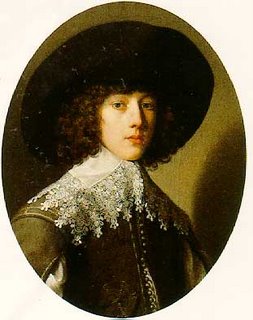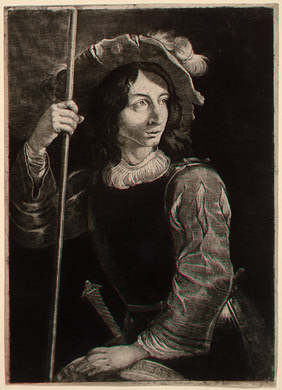
Above, Sir Peter Lely's portrait of Margaret "Peg" Hughes, reputed to be the first woman of English theater – that is, the first female actor to break the all-male tradition of early modern performance, with her portrayal of Desdemona in a December 1660 (Drury Lane?) staging of Othello. Pepys knew her – he knew everyone.
In later years, she became the mistress of
 Prince Rupert of the Rhine [to the left, in very early youth], dashing cavalry commander during the Civil War and admiral during the Dutch Wars. She bore him a daughter, Ruperta, and, it is said, "brought down and greatly subdued his natural fierceness." (A fierceness, according to the Roundheads, only matched by that of his poodle Boye, whom Rupert brought with him into battle and who some of the more superstitious of the Parliamentary soldiers believed was a familiar. Boye died at the battle of Marston Moor.) In Ken Hughes's hilariously inaccurate (yet for me strangely moving) 1970 film Cromwell, Rupert is played by a painfully young Timothy Dalton.
Prince Rupert of the Rhine [to the left, in very early youth], dashing cavalry commander during the Civil War and admiral during the Dutch Wars. She bore him a daughter, Ruperta, and, it is said, "brought down and greatly subdued his natural fierceness." (A fierceness, according to the Roundheads, only matched by that of his poodle Boye, whom Rupert brought with him into battle and who some of the more superstitious of the Parliamentary soldiers believed was a familiar. Boye died at the battle of Marston Moor.) In Ken Hughes's hilariously inaccurate (yet for me strangely moving) 1970 film Cromwell, Rupert is played by a painfully young Timothy Dalton. In his years of exile during the Protectorate, Rupert bounced around Germany (the son of James I's daughter Elizabeth & Frederick V, the Elector Palatine, his first language was German – though he was fluent in perhaps four tongues), amusing himself with experiments in natural philosophy and artistic media. He probably did not invent the mezzotint printing process, but he certainly had a hand in perfecting it. His "Standard Bearer," less famous than "Head of an Executioner," is a fine example of the process.
In his years of exile during the Protectorate, Rupert bounced around Germany (the son of James I's daughter Elizabeth & Frederick V, the Elector Palatine, his first language was German – though he was fluent in perhaps four tongues), amusing himself with experiments in natural philosophy and artistic media. He probably did not invent the mezzotint printing process, but he certainly had a hand in perfecting it. His "Standard Bearer," less famous than "Head of an Executioner," is a fine example of the process.
3 comments:
I think it's funny that women could never find clothes that fit in those days
Interesting that it was Desdemona she was allowed to play.
I'm struck (perhaps smitten would be a better word) by that aspect of Lely's wonderful picture, too. Is this (formally) a portrait of a living person (as opposed to a painting of some historical or genre scene that Peg Hughes happened to model for Lely) and if so what are the social parameters of breast-baring in 17thc female portraiture? Would it be usual for a genteel lady to be painted with a nipple showing? If not (or if so) does it carry some meaning about the sitter's status e.g. as married/unmarried, mother, virgin, mistress, prostitute, bluestocking, actress?
Great piece, by the way.
Is it true that Ruskin said, when he wanted to learn about something he wrote a book about it? I like that remark.
Stop with all the breasts. I am not mature enough to handle it.
aj
Post a Comment